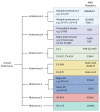Return of the Neurotropic Enteroviruses: Co-Opting Cellular Pathways for Infection
- PMID: 33499355
- PMCID: PMC7911124
- DOI: 10.3390/v13020166
Return of the Neurotropic Enteroviruses: Co-Opting Cellular Pathways for Infection
Abstract
Enteroviruses are among the most common human infectious agents. While infections are often mild, the severe neuropathogenesis associated with recent outbreaks of emerging non-polio enteroviruses, such as EV-A71 and EV-D68, highlights their continuing threat to public health. In recent years, our understanding of how non-polio enteroviruses co-opt cellular pathways has greatly increased, revealing intricate host-virus relationships. In this review, we focus on newly identified mechanisms by which enteroviruses hijack the cellular machinery to promote their replication and spread, and address their potential for the development of host-directed therapeutics. Specifically, we discuss newly identified cellular receptors and their contribution to neurotropism and spread, host factors required for viral entry and replication, and recent insights into lipid acquisition and replication organelle biogenesis. The comprehensive knowledge of common cellular pathways required by enteroviruses could expose vulnerabilities amenable for host-directed therapeutics against a broad spectrum of enteroviruses. Since this will likely include newly arising strains, it will better prepare us for future epidemics. Moreover, identifying host proteins specific to neurovirulent strains may allow us to better understand factors contributing to the neurotropism of these viruses.
Keywords: CRISPR and haploid screens; EV-A71; EV-D68; antivirals; enteroviruses; host-directed therapeutics; neuropathogenesis; picornaviruses; viral tissue tropism; virus–host interactions.
Conflict of interest statement
The authors declare no conflict of interest.
Figures



References
Publication types
MeSH terms
Substances
Grants and funding
LinkOut - more resources
Full Text Sources
Other Literature Sources

